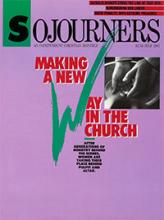I will never forget the conversation a dozen years ago in the plush office of my Methodist conference's district superintendent. Having just returned home to Pennsylvania from a stint of volunteer church work in East Harlem, I was brimming with faith and anticipation. I related the "call" I felt to seek ordination for the purpose of doing urban ministry and committing my life to the furthering of God's kingdom and its vision of social justice.
"But this is a largely rural conference," the district superintendent reminded me. Only a "special appointment" would enable me to do urban ministry.
Read the Full Article

Already a subscriber? Login
